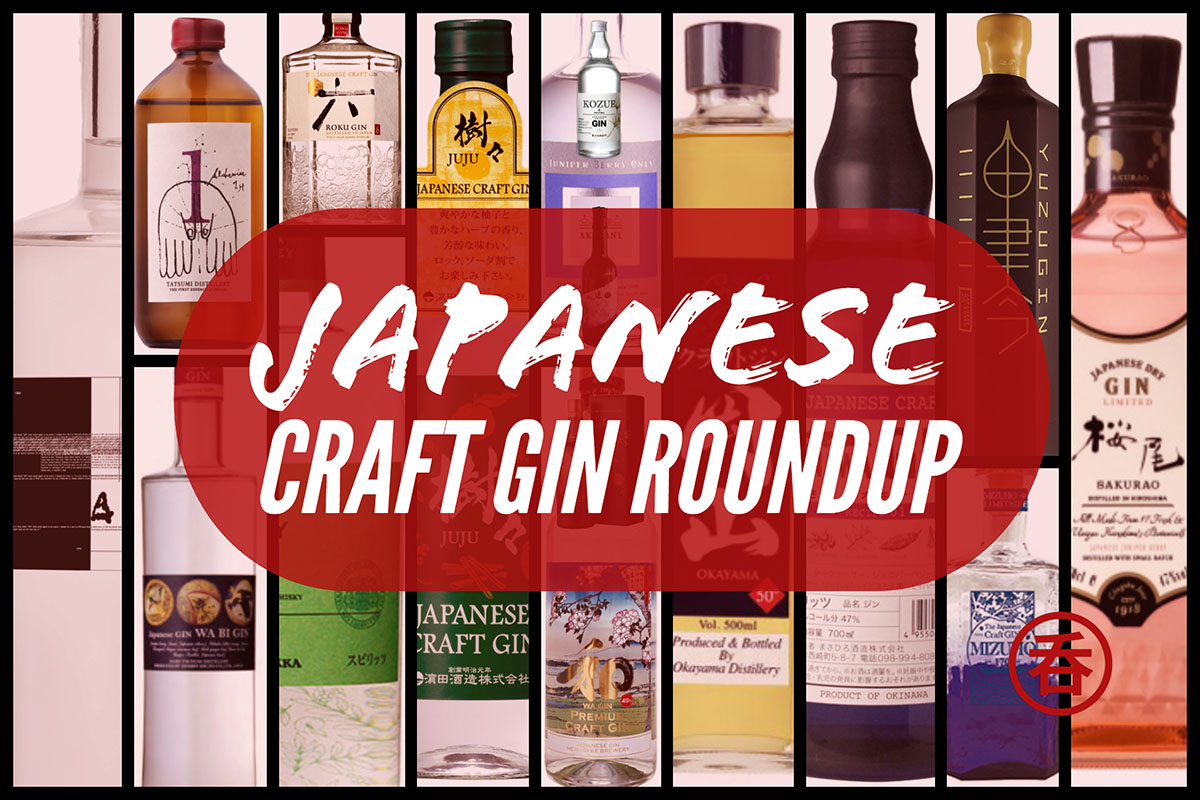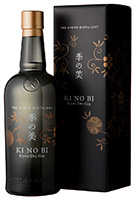Today is World Gin Day 2018! Raise your Copa de Balon, and let’s celebrate! Despite being a relatively new category, we’ve recently seen a craft gin boom here in Japan. Here’s a look at all the Japanese craft gins that have hit the market over the past few years.
 Ki No Bi by The Kyoto Distillery
Ki No Bi by The Kyoto Distillery
This is the one that started it all! First released in August 2016, Ki No Bi gin uses 11 different botanicals including hinoki, yuzu, sansho, ginger, bamboo leaves, and Gyokuro green tea. While nodding in respect to Kyoto’s tradition of craftsmanship, the team led by Alex Davies is constantly innovating, with new expressions like the tea-forward Ki No Tea and navy-strength Ki No Bi “Sei” joining the lineup recently. As Japan’s first craft gin, Ki No Bi has set the trend of utilizing local ingredients to really emphasize the Japanese nature of their gin. Read more
 Nikka Coffey Gin by Nikka Whisky
Nikka Coffey Gin by Nikka Whisky
Nikka Whisky makes the Nikka Coffey Gin at their Miyagikyo Distillery in Miyagi Prefecture. Sansho, citrus such as yuzu, then juniper, are each steeped prior to being individually distilled on Nikka’s old-fashioned Coffey gin. The results are blended with corn and malt distillate, producing a sansho-lover’s dream that goes great in a Gin & Tonic. Read more
 Suntory Roku Gin by Suntory
Suntory Roku Gin by Suntory
With a history of making gin going back to 1936, Suntory’s craft gin Roku Gin was released to much fanfare mid-2017. “Roku” is Japanese for six, signifying the six botanicals that encompass a full year of Japan’s seasons: sakura flower, sakura leaf, sencha, Gyokuro green tea, sansho, and yuzu. These six are combined with eight more traditional gin botanicals such as juniper berry, cardamom seed, cinnamon, and lemon peel. Even the bottle is hexagonal! Read more
 9148 by Benizakura Distillery
9148 by Benizakura Distillery
One of Japan’s few distilleries located within a public park, Hokkaido Liberty Whisky’s Benizakura Distillery launched their craft gin 9148 in early 2018. As of this writing sales are still limited to the distillery itself and select shops in the city of Sapporo, but a few bottles have found their way into the Tokyo area. The name “9148” is a homage to George Orwell’s 1984, where protagonist Winston Smith is forced to drink terrible medicine-like gin under the oppression of Big Brother. 9148 instead values liberty in the world, in values, and in ideas. And they’ve certainly taken some liberties with their botanicals! You’ll find local ingredients like kombu, daikon, and shiitake all in the botanical basket. Read more
 Juju by Hamada Syuzo
Juju by Hamada Syuzo
Kagoshima shochu maker Hamada Syuzo introduced Japanese Craft Gin Juju in May 2018, leaning on 150 years of distillation know-how. Juju contains 7 botanicals such as yuzu, juniper berry, chamomile, and orange peel, combined with a soft and easy-to-drink rice-shochu base. Read more
 Kozue by Nakano Biochemical
Kozue by Nakano Biochemical
Pine needles! That’s one of the primary botanicals you’ll find in Nakano BC’s Kozue Japanese Craft Gin from their Fujishiro Distillery. Super smooth, other local botanicals include mandarin peel and yuzu, all sourced from Wakayama Prefecture. If you’re into earthy, green notes in your gin, this one is definitely worth a try. Read more
 Yuzugin by Kyoya Distiller & Brewer
Yuzugin by Kyoya Distiller & Brewer
Clearly leaning on yuzu as its main botanical, the Miyazaki-made Yuzugin also contains 8 other botanicals like ginger, hyuganatsu, cucumber, and coriander seeds. It’s made through the marrige of a traditional sake brewing technique (simultaneous saccharification and fermentation, SSF) with a new-age low-temperature distillation at 100°C in order demonstrate the breakthroughs that shochu makers have made over the centuries. Read more
 Wa Bi Gin by Hombo Shuzo
Wa Bi Gin by Hombo Shuzo
While they may be better known for their Mars Whisky brand, Hombo Shuzo makes the “Wa Bi Gin” at the Mars Tsunuki Distillery. The botanical basket includes citrus such as Kagoshima-grown kumquat, yuzu, paired with cinnamon, ginger, shiso, and other spices. That’s later blended with gin’s traditional juniper in a koji-based spirit to yield a complex gin with plenty of depth.
 Masahiro Okinawa Gin by Masahiro Distillery
Masahiro Okinawa Gin by Masahiro Distillery
The first gin from Okinawa was Masahiro Distillery’s Masahiro Okinawa Gin Recipe 01. It’s a quite Awamori-heavy gin that uses tropical botanicals like shequasar, goya, hibiscus, and Balinese long pepper. Read more
 Wa Gin by Meiri Shurui
Wa Gin by Meiri Shurui
An ambitious gin from sake maker Tochigi Prefecture’s Meiri Shurui, Wa Gin uses a sake-based spirit that’s aged for then years, giving them a very smooth platform to work from. They add 7 botanicals such as juniper, orange peel, and lemon peel, making this a more traditional gin that works well in gimlets, Singapore Slings, Martinis, and of course G&Ts.
 Craft Gin Mizuho by Mizuho Shuzo
Craft Gin Mizuho by Mizuho Shuzo
Okinawa’s latest awamori distillery to release a craft gin is Mizuho Shuzo, which also happens to be one of the island’s oldest distilleries. It dates back to 1848, before Okinawa was even officially annexed by Japan! Dubbed simply “Craft Gin Mizuho,” Tropical and Fresh varieties are available, where Tropical leans on botanicals like pineapple peel, peach leaf, and citrus, and Fresh features juniper, coriander seed, and lemongrass. In the initial run, only 250 bottles of each are available. Read more
 AWA GIN by Nissin Shurui
AWA GIN by Nissin Shurui
AWA GIN is Shikoku’s only craft gin at the moment, and also one of the few that uses Japanese juniper berries. Only available in extremely limited quantities (think under 100 bottles), other botanicals include yuzu, sudachi, and awa bancha. Read more
 Craft Gin Okayama by Miyashita Shuzo
Craft Gin Okayama by Miyashita Shuzo
At the moment Craft Gin Okayama is Japan’s only regularly available cask-matured craft gin. It’s finished in Japanese oak ex-shochu casks after distillation. Using a soft rice shochu as a base, Miyashita Shuzo adds 10 botanicals such as juniper, malt, lavender, and even hops to yield a strong (50% abv) gin with a slightly golden tint. Read more
 Sakurao Gin by Chugoku Jozo
Sakurao Gin by Chugoku Jozo
Chugoku Jozo has historically been a somewhat controversial player in the Japanese whisky scene, as they imported grain whisky from Scotland & Canada, aged it in Japan, then released it as Togouchi “Japanese whisky.” That all changed last year when they announced the opening of the Sakurao Distillery to begin distilling their own spirits. (Actual) Japanese whisky is an eventual goal, but in the meantime they’ve released two Sakurao Gins: Original and Limited.
Original has 9 botanicals sourced entirely from Hiroshima Prefecture such as hinoki, green tea, orange, and ginger. Limited then goes further by adding some truly unique Hiroshima botanicals like oyster, wasabi, and spicebush, for a total of 17, the most of any Japanese craft gin! Read more
AKAYANE Craft Gin by Sata Souji Shoten
Sata Souji Shoten has been making craft spirits for several years, but it wasn’t until December 2017 that they unveiled their first craft gin. That one used only a single botanical: juniper. It was soon followed up by Akayane Craft Gin Heart (Haru), the first springtime seasonal release that adds botanicals like yuzu, cherry blossom, sansho, and kombu. They will be doing more such seasonal releases going forward, so if you’re looking for a way to capture the essence of a single Japanese season in a bottle of gin, this is your best option. Read more
 Alchemiae Gin by Tatsumi Distillery
Alchemiae Gin by Tatsumi Distillery
This is perhaps the most craft of all the Japanese craft gins in this list. Each batch is handmade by Tatsumi-san–all alone–in his namesake distillery deep in the mountains of Gifu. Water is sourced from the pristine springs of Gujo Hachiman. Fewer than 500 bottles of his gin are released per batch, with each batch bringing new flavor profiles and discoveries. The latest is First Essence Alchemiae Gin Lot2, using a base of sake lees shochu + chicory shochu and juniper as the sole botanical.
Hi there! I created and run nomunication.jp. I’ve lived in Tokyo since 2008, and I am a certified Shochu Kikisake-shi/Shochu Sommelier (焼酎唎酒師), Cocktail Professor (カクテル検定1級), and I hold Whisky Kentei Levels 3 and JW (ウイスキー検定3級・JW級). I also sit on the Executive Committees for the Tokyo Whisky & Spirits Competition and Japanese Whisky Day. Click here for more details about me and this site. Kampai!


 Ki No Bi by The Kyoto Distillery
Ki No Bi by The Kyoto Distillery Nikka Coffey Gin by Nikka Whisky
Nikka Coffey Gin by Nikka Whisky Suntory Roku Gin by Suntory
Suntory Roku Gin by Suntory Juju by Hamada Syuzo
Juju by Hamada Syuzo Kozue by Nakano Biochemical
Kozue by Nakano Biochemical Yuzugin by Kyoya Distiller & Brewer
Yuzugin by Kyoya Distiller & Brewer Wa Bi Gin by Hombo Shuzo
Wa Bi Gin by Hombo Shuzo Masahiro Okinawa Gin by Masahiro Distillery
Masahiro Okinawa Gin by Masahiro Distillery Wa Gin by Meiri Shurui
Wa Gin by Meiri Shurui Craft Gin Mizuho by Mizuho Shuzo
Craft Gin Mizuho by Mizuho Shuzo AWA GIN by Nissin Shurui
AWA GIN by Nissin Shurui Sakurao Gin by Chugoku Jozo
Sakurao Gin by Chugoku Jozo
 Alchemiae Gin by Tatsumi Distillery
Alchemiae Gin by Tatsumi Distillery
2 Comments